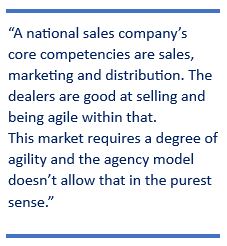Is the agency model a fad that is destined to die?
Stellantis has delayed its agency model introduction and JLR has morphed its plans too in recent weeks. But does this mean the idea of switching from a franchised dealer network model, to a different way of working is faltering or doomed?
While some brands may be taking stock, many car manufacturers do not appear to be abandoning their future plans to introduce agency in the UK at some point. Although some analysts point out that agency looks a better proposition during a demand-led 'pull' new car market than in the emerging market where original equipment manufacturers (OEMs) have stock coming that they must find customers for.
Is the agency model a fad that is destined to die?
Stellantis has delayed its agency model introduction and JLR has morphed its plans too in recent weeks. But does this mean the idea of switching from a franchised dealer network model, to a different way of working is faltering or doomed?
While some brands may be taking stock, many car manufacturers do not appear to be abandoning their future plans to introduce agency in the UK at some point. Although some analysts point out that agency looks a better proposition during a demand-led 'pull' new car market than in the emerging market where original equipment manufacturers (OEMs) have stock coming that they must find customers for.
AM understands Volkswagen Group is still moving ahead with its plans (albeit quietly and much more under the radar than other brands, and leading with EVs only), Ford is still testing the waters in the Netherlands ahead of changes planned for the UK, while Toyota and Honda are also progressing.
Mercedes-Benz and Volvo are also continuing to forge ahead with their already active agency strategies in the UK.
While the path to agency is proving even more challenging than expected, the motivation to change the way new cars are sold and distributed in the UK remains the same. OEMs are looking to claw back higher margins as they struggle to make a profit from producing new electric vehicles (EVs).
The other driving factor is the need to deliver an omnichannel experience that delivers, for new car buyers, transparent pricing and a consistent journey online and in the showroom.
 The benefits for consumers are that they get a transparent view on new car deals - the price is the same nationally, albeit the OEM's support/discount might still change next quarter - and the additional benefit for manufacturers is they can potentially claw back even more margin by selling additional digital services and products directly to consumers with a more direct relationship.
The benefits for consumers are that they get a transparent view on new car deals - the price is the same nationally, albeit the OEM's support/discount might still change next quarter - and the additional benefit for manufacturers is they can potentially claw back even more margin by selling additional digital services and products directly to consumers with a more direct relationship.
Sue Robinson, chief executive of the National Franchised Dealers Association (NFDA), said that while some OEMs may be “putting the brakes on” their plans with agency models, the majority of dealerships appreciate the model will continue to evolve.
Robinson said: “The agency model presents a big change for OEMs with much yet to be understood including on which form agency may take.
 “Despite these developments within the sector, it is crucial to emphasise that dealerships continue to deliver exceptional service and provide the interface relationship between the consumer as well as assistance with the purchase/service of the vehicle.”
“Despite these developments within the sector, it is crucial to emphasise that dealerships continue to deliver exceptional service and provide the interface relationship between the consumer as well as assistance with the purchase/service of the vehicle.”
The NFDA has previously highlighted that one of the key issues surrounding the potential introduction of agency models is the anticipated risk to intra-brand competition, ultimately impacting value for consumers.
Last June, the Competition and Markets Authority (CMA) provided a response to issues highlighted by NFDA surrounding new agency models. Within the response the CMA acknowledged to NFDA that they understand the implications of these models on both the financial and consumer side.
Agency is a change management project
Steve Young, ICDP managing director, is working directly with Stellantis to help mediate between its retailers, following the company’s decision to delay the introduction of agency.
Speaking more generally about the market, Young said that some OEMs have been unrealistic about how long it would take to implement an agency model.
“It’s the fact that it’s being approached as an IT project, plus a contractual change. But it’s more fundamental than that. It’s a change management project and that’s not something that can be implemented overnight.”
Young described agency as a big change for OEMs, retailers and customers and the extent of the readiness for change from some manufacturers in terms of process, people and systems was “poor”.
He believes changing the way the automotive retail business operates is something that is going to take two to three years and needs to be a step-by-step process, rather than flicking a switch.
Tony Whitehorn, automotive industry consultant and former leader of brands in the UK like Hyundai and Toyota, has vast experience working with networks from the national sales company’s perspective.
He said: “The agency model isn’t dead, it’s just morphing into an acceptable business model for all parties.
 “A national sales company’s core competencies are sales, marketing and distribution.
“A national sales company’s core competencies are sales, marketing and distribution.
“The dealers are good at selling and being agile within that. This market requires a degree of agility and the agency model doesn’t allow that in the purest sense.”
Are dealers making money on the agency model?
Young said most retailers react with “relief, rather than glee” over delays to the introduction of agency.
Both Young and Whitehorn said that even the most cynical of retailers are of the opinion that they can accept a new way of working if it means a similar or improved level of income for them.
Retailers may have been making around 5-6% margin from OEMs on new vehicles and agency agreements include a set handover margin of a similar 5-6%.
So while margins may be similar, the dynamics of pushing stock and getting deals over the line is a different prospect with agency.
Young said profitability with agency is a base line. He said the issue with agency agreements is not necessarily the terms, but the impact to volumes of vehicles sold.
He said: “You need volume x handover fee in order to get to the right revenue. If an OEMs’ volumes are down then the dealer isn’t going to get the revenues.”
Whitehorn said agency changes the focus of retailers from the initial sale to the handover.
Dealers can still introduce things like service plans to secure future aftersales work and continue to sell ancillary services.
What happens next with agency?
Both Young and Whitehorn expect OEMs to continue with their agency plans, but they will take more time and work to get right.
Whitehorn said pure agency is quite binary, but new approaches will likely adapt a traditional franchise model with pricing transparency, online transactions and developing more direct relationships with customers.
Young said the OEMs are still working on IT bugs and systems in general that will help to better underpin this new way of working, where the customer journey is managed seamlessly between online, the showroom, as well as the OEM’s and retailer’s own systems.
He also described the OEMs as having “a mountain to climb” in terms of getting the retail skills needed to be more attuned to local markets.
 Young said: “Sales executives of every network have been doing dynamic pricing on behalf of the OEM deal by deal forever.
Young said: “Sales executives of every network have been doing dynamic pricing on behalf of the OEM deal by deal forever.
“Under agency, the OEMs are setting the pricing so they need to do a better job. It requires data, analytical tools and a sensitivity to the market that the OEMs have never had to have in the past.
“The problem was that going live with agency during a pull market in the pandemic means you haven’t really learnt anything about how to operate this new way of working in a push market, which is what we’re in now.
“At one extreme, you have Tesla, which is direct to consumer, rather than agency, cutting prices by £5,000.
“Where you need to be is pricing adjustments that are much more subtle and probably managed within the finance deal so that the customer is still getting a deal, but it’s not explicitly a great big £3,000 reduction.
“That’s going to be a product by product, month by month basis.”
This dynamic pricing could take a similar approach to airlines and hotels, which base pricing on supply and demand.
Young said: “That’s the principle of the Mercedes dynamic pricing model. You look at the order fill for the months ahead and you see how it’s filling up relative to the objective. You can then adjust promotions to each car depending on how orders are filling up.
“If it’s filling up faster, you ease off on promotions. If it’s not going quickly enough, you put more promotions behind it.”
Pre-registrations under agency
One thing Young was very clear about was that pre-registrations under agency could spell disaster for OEMs.
The UK new car market is moving into oversupply, so OEMs would ordinarily have pre-registered vehicles to start moving new car stock on.
Young said: “Anytime a dealer has nearly new stock on his balance sheet and the opportunity is there to sell a car on agency that will only earn them 6%, what are they going to do?
 “The OEM finance will look more attractive for customers on a brand new car, but if the dealer group has been able to do a heavy discount deal on that nearly new stock, they’re going to do a deal for the customer.
“The OEM finance will look more attractive for customers on a brand new car, but if the dealer group has been able to do a heavy discount deal on that nearly new stock, they’re going to do a deal for the customer.
“It’s why BMW has said that for their agency model, they include nearly new up to 18 month old vehicles.”
Login to continue reading
Or register with AM-online to keep up to date with the latest UK automotive retail industry news and insight.

















Login to comment
Comments
No comments have been made yet.